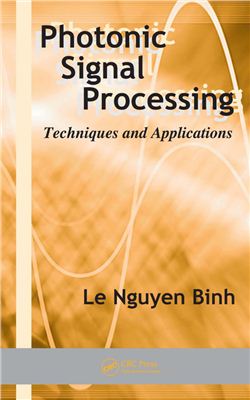Издательство CRC Press, 2008, -382 pp.
Photonic signal processing (PSP) is very attractive because it has the potential to overcome the electronic limits for processing ultra-wideband signals. Furthermore, PSP provides signal conditioning that can be integrated in-line with fiber optic systems. Several techniques have been proposed and reported for the implementation of the photonic counterparts of conventional electronic signal processing systems. Signal processing in the photonic domain offers significant improvement of signal quality.
This book was written to address the emerging techniques of processing and manipulating of signals propagating in an optical domain. This means the pulses or signal envelopes are complex or modulating the optical carriers. Naturally, the applications of such processing techniques in photonics are essential to illustrate their usefulness. The change of the transmission cable from coaxial and metallic waveguide to flexible optically transparent glass fiber has allowed the processing of ultra-high-speed signals in the microwave and millimeter-wave domain to the photonic domain in which the delay line can be implemented in the fiber lines, which are very lightweight and space efficient.
Chapter 1 gives a brief historical perspective of PSP and an introduction to a number of photonic components essential for photonic processing systems, including, but not exclusively, optical amplification devices, optical fibers, and optical modulators. Chapter 2 discusses the representation of photonic circuits using signal-flow graph techniques, which have been employed in electrical circuits since the 1960s; however, they have been adapted for photonic domains in which the transmittance of a photonic subsystem determines the optical transfer function of a photonic subsystem. The coherent and incoherent aspects of photonic circuits are important in terms of whether the field or the power of the lightwaves should be used as well as because the length of the photonic processors must be less than that of the coherence length.
Photonic signal processors such as differentiators and integrators are described in Chapter
3. Their applications in the generation of solitons and in optically amplified fiber transmission systems are described in Chapter
4. Chapter 5 illustrates the compensation of dispersion using photonic processors. Chapter 6 explains the design of optical filters using photonic processing techniques.
Principal Photonic Devices for Processing
Incoherence and Coherence in Photonic Signal Processing
Photonic Computing Processors
Ultrashort Pulse Photonic Generators
Dispersion Compensation Using Photonic Filters
Tunable Optical Filters
Photonic signal processing (PSP) is very attractive because it has the potential to overcome the electronic limits for processing ultra-wideband signals. Furthermore, PSP provides signal conditioning that can be integrated in-line with fiber optic systems. Several techniques have been proposed and reported for the implementation of the photonic counterparts of conventional electronic signal processing systems. Signal processing in the photonic domain offers significant improvement of signal quality.
This book was written to address the emerging techniques of processing and manipulating of signals propagating in an optical domain. This means the pulses or signal envelopes are complex or modulating the optical carriers. Naturally, the applications of such processing techniques in photonics are essential to illustrate their usefulness. The change of the transmission cable from coaxial and metallic waveguide to flexible optically transparent glass fiber has allowed the processing of ultra-high-speed signals in the microwave and millimeter-wave domain to the photonic domain in which the delay line can be implemented in the fiber lines, which are very lightweight and space efficient.
Chapter 1 gives a brief historical perspective of PSP and an introduction to a number of photonic components essential for photonic processing systems, including, but not exclusively, optical amplification devices, optical fibers, and optical modulators. Chapter 2 discusses the representation of photonic circuits using signal-flow graph techniques, which have been employed in electrical circuits since the 1960s; however, they have been adapted for photonic domains in which the transmittance of a photonic subsystem determines the optical transfer function of a photonic subsystem. The coherent and incoherent aspects of photonic circuits are important in terms of whether the field or the power of the lightwaves should be used as well as because the length of the photonic processors must be less than that of the coherence length.
Photonic signal processors such as differentiators and integrators are described in Chapter
3. Their applications in the generation of solitons and in optically amplified fiber transmission systems are described in Chapter
4. Chapter 5 illustrates the compensation of dispersion using photonic processors. Chapter 6 explains the design of optical filters using photonic processing techniques.
Principal Photonic Devices for Processing
Incoherence and Coherence in Photonic Signal Processing
Photonic Computing Processors
Ultrashort Pulse Photonic Generators
Dispersion Compensation Using Photonic Filters
Tunable Optical Filters

